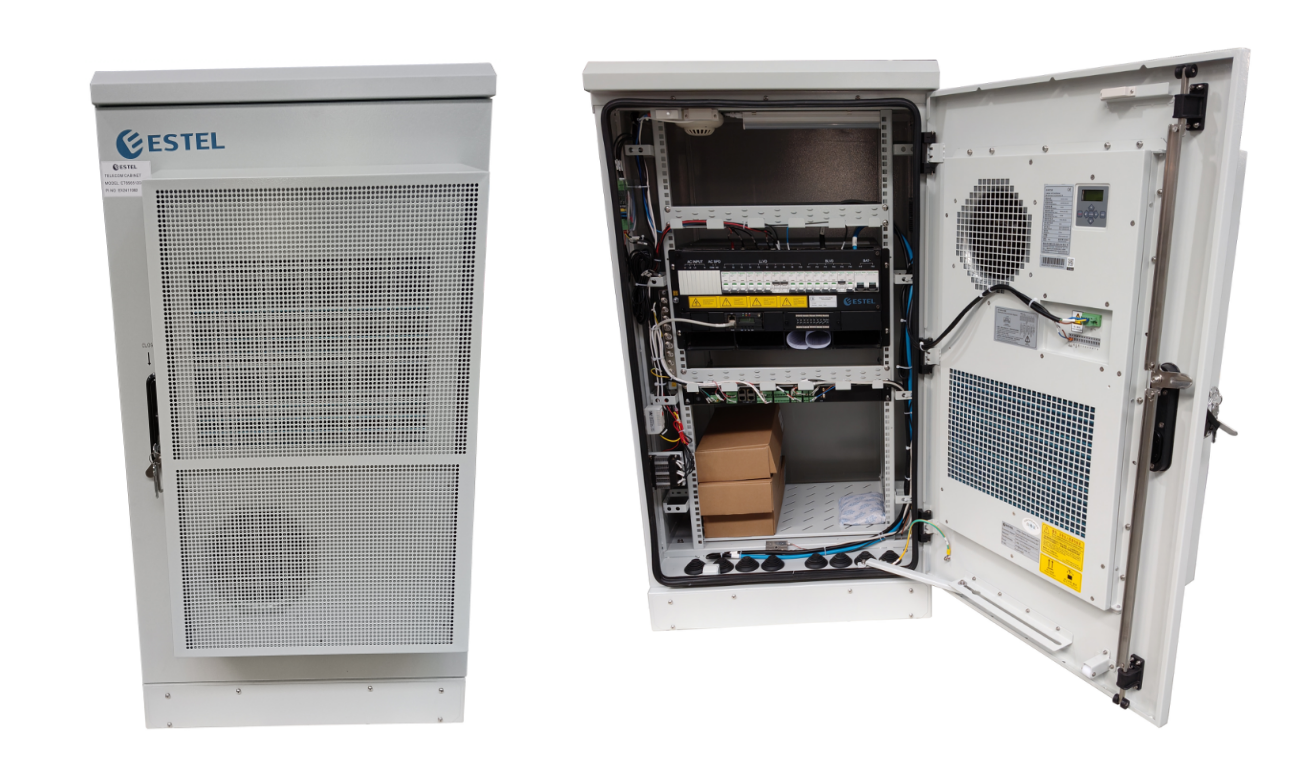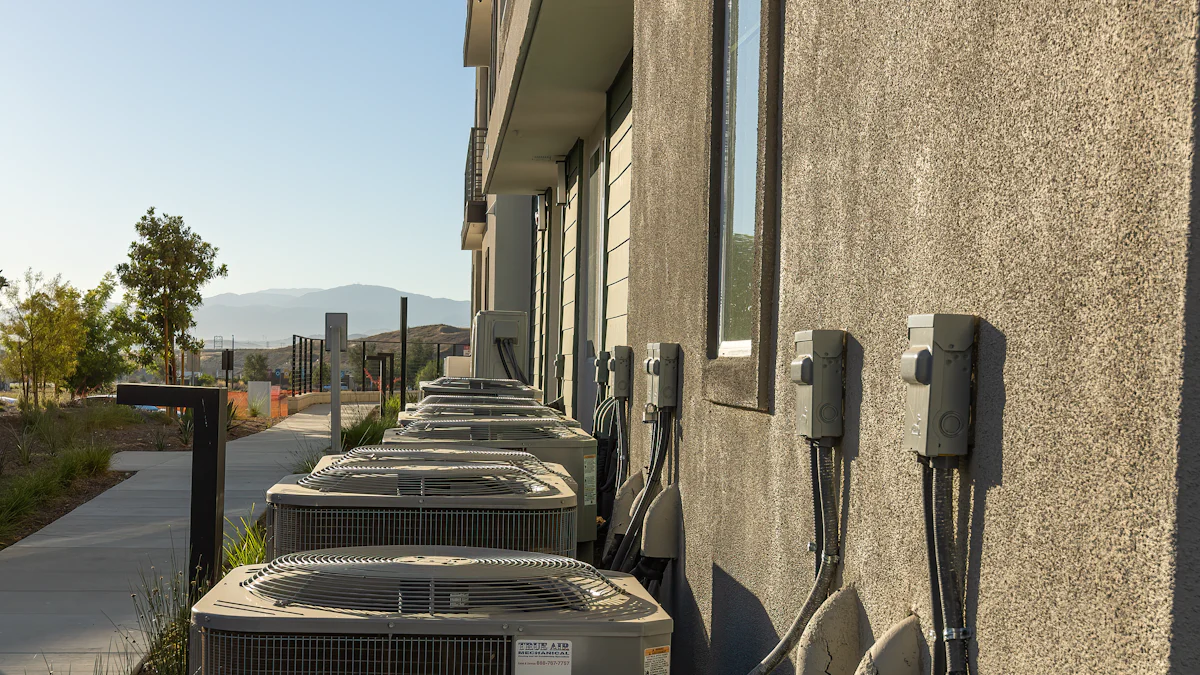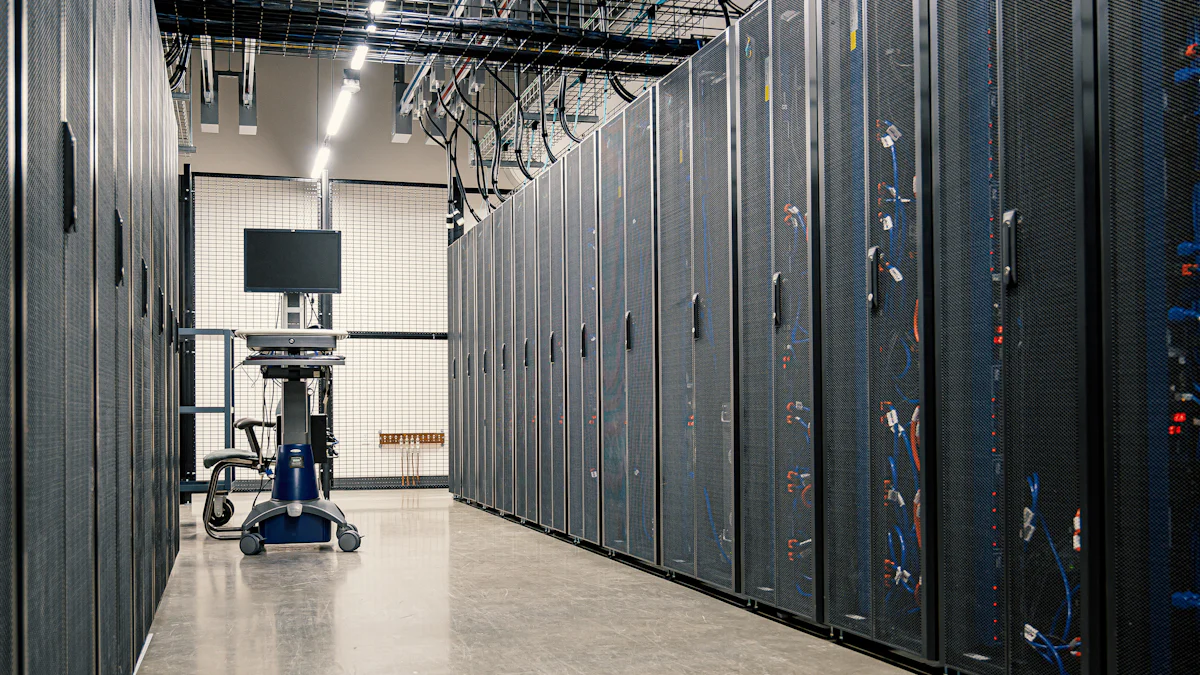How Communication Air Conditioning Protects Sensitive Equipment

Sensitive equipment in communication systems demands a stable environment to function reliably. Temperature fluctuations, dust, and humidity can compromise performance and lead to costly failures. You need a solution that ensures consistent protection against these challenges. Communication air conditioning (通信空调) systems provide this safeguard by maintaining optimal conditions. These systems regulate temperature, control humidity, and filter out harmful particles. By doing so, they shield your equipment from environmental stress and extend its operational life. Investing in such technology ensures your communication infrastructure remains efficient and dependable.
Key Takeaways
Communication air conditioners keep temperatures steady, stopping overheating and helping equipment last longer.
They remove dust and dirt, keeping electronics safe and working well.
Controlling humidity is important; these systems stop moisture that can cause rust or electrical problems.
Using these systems lowers repair costs and prevents delays, making networks more reliable.
Modern air conditioners help important systems work nonstop, even in tough situations or emergencies.
Challenges Faced by Communication Cabinets
Temperature Fluctuations
Effects of extreme heat on electronic components
Excessive heat can severely damage the sensitive electronics housed in telecom cabinets. Prolonged exposure to high temperatures accelerates the degradation of components, reducing their lifespan. Heat can also cause solder joints to weaken, leading to circuit failures. Maintaining a stable internal temperature is critical to prevent these issues.
Condition | Temperature Range |
|---|---|
External Ambient Temperature | -30° C to 55° C |
Equipment Chamber Temperature | 20/30 °C to 65/85 °C |
Optimum Battery Temperature | 25° C |
Risks of condensation from low temperatures
Low temperatures can lead to condensation inside telecom cabinets. This moisture can corrode metal components and create short circuits, jeopardizing the reliability of your equipment. Proper insulation and temperature control are essential to mitigate this risk.
Environmental Hazards
Dust and debris accumulation
Dust accumulation poses a significant threat to the performance of sensitive electronics.
Dry dust insulates components, causing overheating.
Wet dust can lead to electrical shorts and permanent damage.
Dust build-up hinders internal fans, reducing cooling efficiency.
Insulating layers of dust trap heat, increasing the risk of hardware failure.
Humidity and its impact on sensitive electronics
Humidity introduces conductive particles into the environment, which can cause electrical shorts and high-voltage discharges. These conditions often result in catastrophic failures, including system crashes and data loss. Effective humidity control is vital to protect your equipment.
Overheating Risks
Causes of heat buildup in communication cabinets
Several factors contribute to overheating in telecom cabinets:
High-density equipment generates excessive heat.
Poor airflow restricts heat dissipation.
High ambient temperatures exacerbate internal heat levels.
Inadequate ventilation or cooling systems fail to regulate temperatures effectively.
Consequences of overheating on equipment reliability
Overheating compromises the reliability of your equipment. It can lead to thermal shutdowns, reduced performance, and permanent damage to critical components. Ensuring proper cooling mechanisms is essential to maintain operational stability.
How Communication Air Conditioning (通信空调) Systems Address These Challenges

Temperature Regulation
Cooling mechanisms for consistent temperature control
Communication air conditioning systems excel at maintaining a stable internal climate for your equipment. These systems use advanced cooling solutions, such as compressor-based cooling and heat exchangers, to regulate temperatures effectively. Outdoor cabinet air conditioners, for example, are designed to handle extreme external conditions while ensuring the internal temperature remains within safe limits. This precise control prevents temperature spikes that could damage sensitive electronics.
Preventing thermal shutdowns and overheating
Thermal shutdowns occur when equipment overheats, forcing systems to power down to avoid permanent damage. Communication air conditioning systems prevent this by dissipating excess heat efficiently. Features like double-walled insulation in outdoor cabinet air conditioners enhance cooling performance, ensuring your equipment operates reliably even during peak heat conditions.
Protection from Environmental Factors
Filtering out dust and debris
Dust and debris can wreak havoc on your equipment, but communication air conditioning systems incorporate specialized filters to combat this issue. These filters trap harmful particles, keeping the internal environment clean.
Filter Type | Description | Effectiveness Against Dust and Debris | Pros and Cons |
|---|---|---|---|
Fiberglass Air Filters | Flat-paneled design with fiberglass media. | Low | Cheapest option; filters large particles but not effective for respiratory issues. |
Pleated Filters | Made of polyester or cotton folds; more pleats improve filtration. | Moderate | Good balance of cost and efficiency; available in washable/disposable types. |
Electrostatic Filters | Uses static charge to attract small airborne particles. | High | Removes a wide range of allergens; more expensive but effective. |
HEPA Filters | Captures particles down to 0.3 microns; very effective for air quality. | Very High | Ideal for respiratory issues; can impede airflow, so must be used as recommended by AC manufacturers. |
Electrostatic and HEPA filters are particularly effective for outdoor cabinet air conditioners, offering superior protection against fine particles.
Managing humidity to prevent corrosion
High humidity levels can lead to corrosion and electrical shorts. Communication air conditioning systems manage humidity by using dehumidifiers and moisture-resistant coatings. These features ensure your equipment remains safe from the damaging effects of moisture, even in challenging environments.
Enhancing Equipment Safety
Reducing fire hazards
Overheating and dust accumulation increase the risk of fire. Communication air conditioning systems mitigate this by maintaining optimal temperatures and filtering out flammable particles. This proactive approach significantly reduces fire hazards, ensuring the safety of your equipment.
Ensuring stable operation in extreme conditions
Outdoor cabinet air conditioners are engineered to perform in harsh environments. With features like corrosion-resistant materials and robust cooling mechanisms, these systems ensure stable operation even in extreme weather. This reliability is crucial for maintaining uninterrupted communication services.
Benefits of Communication Air Conditioning (通信空调)

Improved Equipment Performance
Stable operation under controlled conditions
Communication air conditioning systems ensure your equipment operates in a stable environment. By maintaining consistent temperatures and controlling humidity, these systems eliminate the risks associated with environmental fluctuations. For example, outdoor cabinet air conditioners are specifically designed to handle extreme external conditions while keeping the internal climate optimal. This stability allows your sensitive electronics to perform at their peak, ensuring uninterrupted operations.
Reduced risk of malfunctions and downtime
Malfunctions often result from overheating, condensation, or dust accumulation. Communication air conditioning systems address these issues by providing precise cooling, effective filtration, and humidity control. This proactive approach minimizes the likelihood of equipment failures, reducing downtime and ensuring your communication network remains reliable.
Extended Equipment Lifespan
Minimizing wear and tear from environmental stress
Environmental stress, such as high temperatures and humidity, accelerates the degradation of electronic components. Communication air conditioning systems protect your equipment by creating a controlled environment that minimizes exposure to these harmful factors. Outdoor cabinet air conditioners, for instance, use advanced cooling and insulation technologies to shield your equipment from external stressors, significantly reducing wear and tear.
Delaying the need for replacements
By safeguarding your equipment from environmental damage, communication air conditioning systems extend its operational life. This delay in the need for replacements not only saves you money but also ensures your infrastructure remains functional for longer periods. Investing in these systems is a cost-effective way to maximize the value of your equipment.
Cost Efficiency
Lower maintenance and repair costs
Frequent repairs and maintenance can strain your budget. Communication air conditioning systems reduce these costs by preventing common issues like overheating, corrosion, and dust-related damage. With fewer breakdowns, you can allocate resources more efficiently and focus on expanding your communication network.
Enhanced energy efficiency of cooling systems
Modern communication air conditioning systems are designed with energy efficiency in mind. Features like variable-speed compressors and intelligent temperature controls optimize energy usage, reducing operational costs. Outdoor cabinet air conditioners, in particular, offer energy-efficient solutions that maintain performance without excessive power consumption. This efficiency benefits both your budget and the environment.
The Role of Communication Air Conditioning (通信空调) in Reliable Communication Systems
Ensuring Network Uptime
Preventing disruptions caused by equipment failure
Reliable communication systems depend on uninterrupted operation. Equipment failures, often caused by overheating or environmental stress, can disrupt your services. Communication air conditioning systems prevent these issues by maintaining optimal conditions inside telecom cabinets. By regulating temperature and controlling humidity, these systems protect sensitive electronics from damage. This proactive approach ensures your equipment remains operational, reducing the risk of unexpected downtime.
Supporting continuous data transmission
In modern communication networks, uninterrupted data flow is critical. Any disruption can lead to delays, data loss, or compromised connectivity. Communication air conditioning systems play a vital role in supporting continuous data transmission. By preventing overheating and maintaining stable environmental conditions, these systems ensure that your equipment performs consistently. This stability is essential for delivering seamless communication services to your users.
Supporting Critical Infrastructure
Importance in telecommunications and IT industries
Telecommunications and IT industries form the backbone of global connectivity. These sectors rely on robust infrastructure to support data centers, base stations, and telecom cabinets. Communication air conditioning systems safeguard this infrastructure by protecting the equipment that powers it. Without proper cooling and environmental control, your systems could face frequent failures, jeopardizing critical operations. Investing in advanced air conditioning solutions ensures your infrastructure remains reliable and efficient.
Role in disaster recovery and emergency systems
During emergencies, communication networks become lifelines for coordination and information sharing. Equipment failures during such times can have severe consequences. Communication air conditioning systems enhance the resilience of your infrastructure by ensuring stable operation even in extreme conditions. Whether it’s a natural disaster or a power outage, these systems help maintain the functionality of emergency communication systems, enabling you to respond effectively when it matters most.
Communication air conditioning (通信空调) plays a crucial role in protecting sensitive equipment in communication cabinets. It addresses challenges like temperature fluctuations, dust, and humidity, ensuring your equipment operates under optimal conditions. These systems enhance performance, extend the lifespan of your devices, and reduce the risk of costly failures. By investing in advanced air conditioning solutions, you can maintain seamless communication, improve reliability, and lower operational expenses. Safeguarding your infrastructure with these systems ensures your network remains efficient and dependable in any environment.
FAQ
What is communication air conditioning, and why is it important?
Communication air conditioning ensures optimal environmental conditions for sensitive equipment in telecom cabinets. It regulates temperature, controls humidity, and filters out harmful particles. This system protects your equipment from overheating, corrosion, and dust, ensuring reliable performance and extending its lifespan.
How does communication air conditioning prevent overheating?
These systems use advanced cooling mechanisms like compressor-based cooling and heat exchangers. They dissipate excess heat efficiently, maintaining a stable internal temperature. This prevents thermal shutdowns and ensures your equipment operates reliably, even in extreme conditions.
Can communication air conditioning systems handle outdoor environments?
Yes, outdoor cabinet air conditioners are specifically designed for harsh environments. They feature corrosion-resistant materials, robust cooling systems, and IP-rated protection against dust and moisture. These features ensure stable operation in extreme weather conditions.
How do these systems manage humidity?
Communication air conditioning systems use dehumidifiers and moisture-resistant coatings to control humidity levels. These features prevent condensation, corrosion, and electrical shorts, safeguarding your sensitive electronics from moisture-related damage.
Are communication air conditioning systems energy-efficient?
Modern systems prioritize energy efficiency with features like variable-speed compressors and intelligent temperature controls. These technologies optimize energy usage, reducing operational costs while maintaining high performance. This makes them both cost-effective and environmentally friendly.
See Also
The Importance Of Air Conditioning In Outdoor Cabinets
Safeguarding Equipment Using Outdoor Telecom Cabinets
Ensuring Outdoor Cabinets Last With Smart Maintenance
CALL US DIRECTLY
86-13752765943
3A-8, SHUIWAN 1979 SQUARE (PHASE II), NO.111, TAIZI ROAD,SHUIWAN COMMUNITY, ZHAOSHANG STREET, NANSHAN DISTRICT, SHENZHEN, GUANGDONG, CHINA

